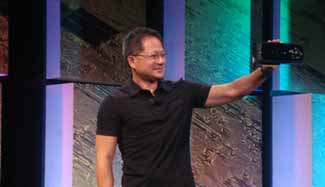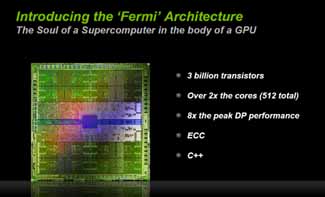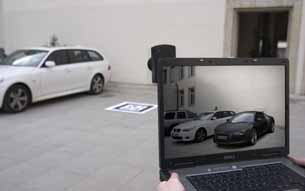Latest News
October 8, 2009
By Kenneth Wong
About an hour past high noon last Wednesday (September 30, 2009), inside the Fairmont hotel in San Jose, California, NVIDIA’s cofounder and president Jen-Hsun Huang stepped up to the podium to face his fans. In a ballroom lit in the palm-green glow that NVIDIA has adopted for its brand, his captive audience awaited. They consisted of physicists, medical researchers, game developers, product designers, and filmmakers. From envisioning a cross-section of the human body at cellular level to studying subatomic particles in a nuclear explosion, they had been harnessing the computing horsepower of graphics processors to visualize what they previously had to use the mind’s eye to see. In Huang’s words, they have “caught the bugs of GPU computing.”
Huang’s gift to the GPU Technology Conference attendees was, as he put it, “the soul of a supercomputer in the body of a GPU.” Codenamed Fermi, the new NVIDIA chip is described as “a miserly 3 billion transistors, an absolute powerhouse.”
The Soul of a Supercomputer
Fermi is, according to Huang, not “a GPU that has been extended for general purpose computing” but “a brand new architecture designed from the ground up to be a computer first … ]that treats] computer graphics and parallel computing as equal citizens.”
The current generation NVIDIA GPU (Tesla C1030) is, in Huang’s estimate, about “30 times faster than a CPU.” Tesla comes with 240 CUDA computing cores. Consider, then, the fact that Fermi is designed with 512 cores, more than twice the number in Tesla.
As market leader in GPU, NVIDIA has been advocating the use of GPU in areas where the CPU’s performance might not be up to the challenge. CPU leader Intel is currently developing a new generation of chips codenamed Larrabee, designed to take advantage of parallel computing and multicore processing. In other words, it’s the soul of a supercomputer in a CPU.
Judging from Huang’ words, Fermi is meant to be a general computing device (or a super computing device), not just a graphics booster. Its debut puts NVIDIA squarely in Intel’s territory. When multi-core processing (not just dual-core or quad-core but many cores bunched together in a single chip) becomes the order of the day, GPU and CPU may begin to look a lot like each other.
For more on Larrabee, visit Intel’s product homepage here.
For more on Fermi, visit NVIDIA’s product homepage here.
 Fig 1. NVIDIA’s cofounder and president Jen-Hsun Huang presents the next generation GPU, codenamed Fermi, at the NVIDIA GPU Technology Conference on September 30, 2009. |  Fig 2. The new NVIDIA GPU Fermi, according to the company, is “the soul of a supercomputer in the body of a GPU.” |
Augmented Reality
Among the beneficiaries of GPU’s technological advances are engineers and designers. Realistic rendering with ray-tracing, now part of the appeal of many leading CAD programs, is one of the visualization exercises made possible by GPU. The feature is, in fact, what Autodesk routinely pitches to its automotive clients as an argument in favor of digital prototyping.
At last week’s NVIDIA GPU Technology Conference, some exhibitors came to showcase their cutting edge graphics solutions that could usher in a whole new mode of visualization. With software and services from RTT, one of the companies that shared the stage with NVIDIA’s chief Huang during the opening day keynote address, you move beyond virtual reality to enter what’s called augmented reality: the place where digital objects and real objects coexist.
 Fig 3. RTT, an exhibitor at NVIDIA GPU Technology Conference, uses its software RealView to merge digital objects (in this case, the black automobile in the laptop screen, represented by the marker on the ground) with real objects in the physical environment (the white car in the parking lot). |
RTT’s RealView software allows you to associate a physical marker (a signboard with a graphics symbol printed on it) with a digital object, such as a new tire-rim design or a new car model. This allows you to, for instance, place a marker on a real vehicle’s wheel, then visualize the same vehicle on a display screen with tire rims that exist only as digital models. (See the company’s demonstration video here.)
“Design and marketing will increasingly go hand in hand,” said Ludwig Fuchs, cofounder of RTT’s parent firm RTT AG. With his company’s technologies, Fuchs anticipates automakers will design their next-generation products and promote them at the same time.
The effortless import of digital designs into the physical world—or vice versa—would allow you to study, for example, several dashboard designs to determine how they will behave under daylight, sunlight, and twilight—before these dashboards are built. RealView can synchronize the lighting conditions in the real world and apply them to the digital objects incorporated into them, so the virtual-physical amalgam in the display unit looks natural, complete with ray-tracing and realistic shadow casting.
Subscribe to our FREE magazine, FREE email newsletters or both!
Latest News
About the Author
Kenneth Wong is Digital Engineering’s resident blogger and senior editor. Email him at [email protected] or share your thoughts on this article at digitaleng.news/facebook.
Follow DE





